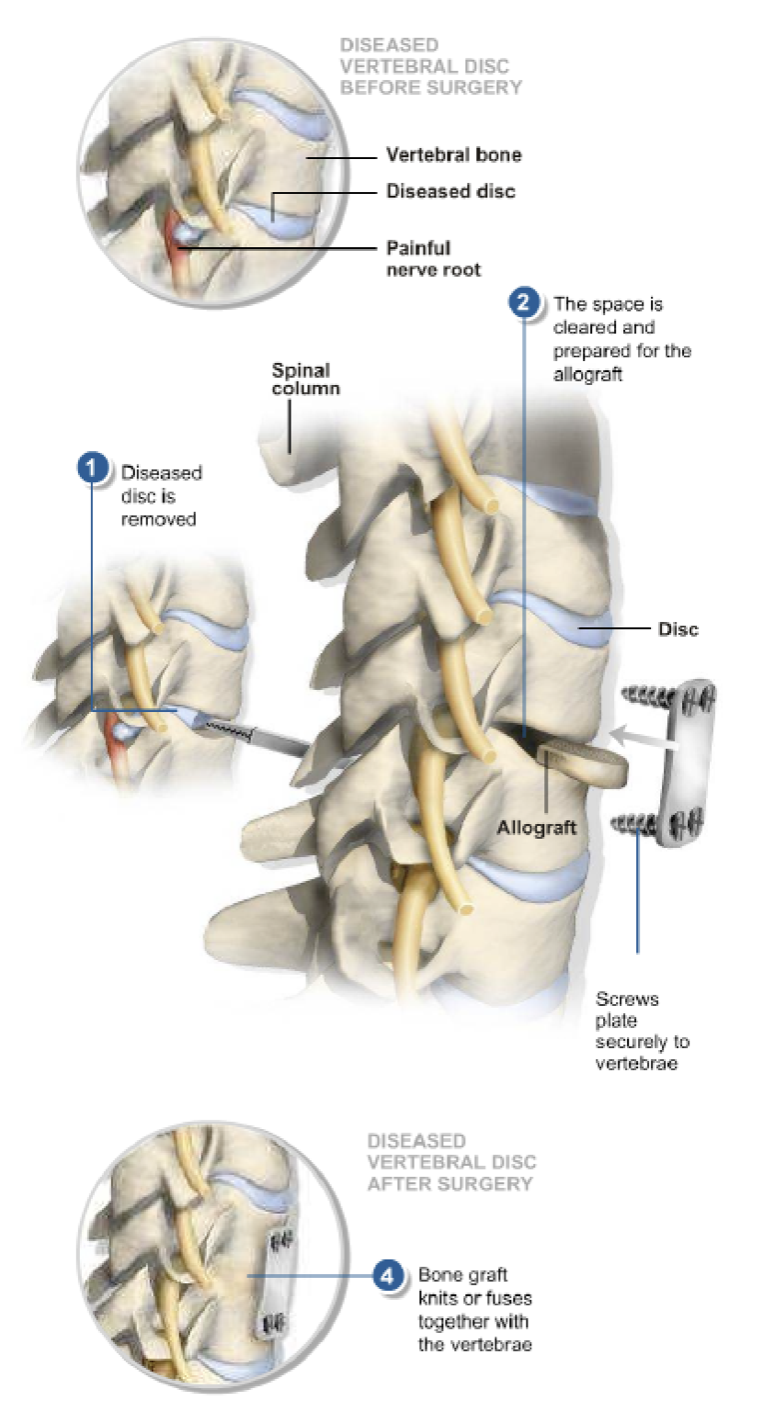- Home
- Anterior Cervical Discectomy & Fusion (ACDF) old

Anterior Cervical Discectomy & Fusion (ACDF)
- Home
- Anterior Cerv...
Anterior Cervical Discectomy And Fusion (ACDF)
Anterior Cervical Discectomy and Fusion (ACDF) is a surgical procedure in which one or more of the cervical discs is removed and replaced with either a block of bone or a fusion device to allow the bone to fuse across the disc space.
Advantages of ACDF Surgery:
- Minimally Invasive – 1 inch incision
- 90% effective for relief of arm pain due to a pinched nerve
- Return to high-level athletic activity following recovery
If You Have Decided to Have Surgery:
- Call our doctor,s staff to schedule your surgery date and the date for your pre-operative consultation.
- At your pre-operative consultation doctor will discuss the procedure with you, answer any questions you may have, and have you sign a consent form for surgery.
- You will be given prescriptions for pain medicine and instructions for post-operative care.
- Your pre-operative evaluation will be scheduled on the same day as your pre-operative consultation. You may have a chest X-ray, EKG, and blood-work performed.
- If you take aspirin or anti-inflammatory medications daily, STOP these medications at least 5 days before your surgery.
- If you are a smoker you should make every effort to stop smoking as soon as you can before surgery (at least 2 weeks prior to surgery). You should not smoke for at least 6 weeks after surgery.
- You will check into the hospital or the surgery center the morning of surgery.
Surgical Procedure:
- Your anesthesiologist will bring you to the operating room and put you to sleep for the operation.
- There are usually two nurses in the room and a surgical assistant that assists Doctor with the operation.
- A small horizontal incision (usually about one inch) is made on the front of your neck, usually just to the right of your “Adam’s apple”.
- After carefully moving the muscle tissue, retractors are placed to expose the front of the spine.
- The disc is then removed from between the bones and any herniated disc material or bone spurs are pulled away from the nerves and spinal cord, relieving the pressure.
- The bone graft or fusion device is then placed into the disc space and a small titanium plate is placed over the bones and attached with screws.
- A small drain is usually placed in the incision to prevent any bloody drainage from collecting underneath. This is removed the next morning.
- The incision is closed with resorbable stitches that are placed beneath the skin.
- A soft collar is usually placed on your neck before you leave the operating room.
- The surgery will take approximately 1.5-2 hours depending on the number of discs to be fused.


After Surgery:
- You will be taken to the recovery room and stay there for about 1 hour. Afterwards you will be transferred to your room where you can visit with your family.
- You will be discharged approximately 2 days after the surgery.
- Doctor will speak to your family while you are in the recovery room.
- The nurses will get you out of bed shortly after surgery and the physical therapists will work with you to ensure that you are strong enough to walk and climb stairs.
- The surgical dressing will be changed and the small drain removed the morning after surgery. The new dressing will stay on for 14 days.
After Going Home:
- You will be given pain medication and a muscle relaxant to help control post-operative pain and spasms. Make sure you do not drive or operate heavy machinery while on the medication.
- You will have a post-operative office visit with Doctor 2 weeks after surgery.
- You will need to wear the soft cervical collar at all times for the first 2 weeks.
- You may drive after two weeks once you are out of the collar and off of your medications.
- You can expect to return to sedentary office or desk work approximately 1-2 weeks after surgery.
- If you perform manual labor that requires heavy lifting or frequent bending or climbing you should wait 3 months before returning to this activity. You can return to moderate duty at 4-6 weeks.
- Doctor will see you again 3 months after surgery.
- You will start a rehabilitation program with the physical therapist 6-12 weeks after surgery.
- X-rays will be taken at each of your post-op visits. The fusion is usually seen to be solid by 3 to 6 months.
- Sports activities such as golf or tennis may be resumed at 3 months if the fusion is solid.


